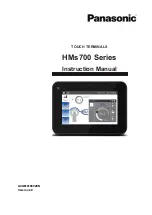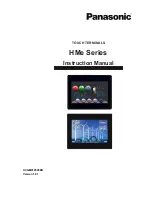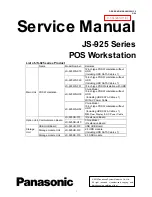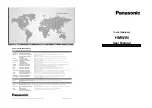
3
I
NSTALLING AND
P
OWERING THE
306
MOUNTING INSTRUCTIONS
This operator interface is designed for through-panel mounting. A panel cut-
out diagram and a template are provided. Care should be taken to remove any
loose material from the mounting cut-out to prevent that material from falling
into the operator interface during installation. A gasket is provided to enable
sealing to NEMA 4X/IP66 for indoor use specification. Install the ten kep nuts
provided and tighten evenly for uniform gasket compression.
Note: Tightening the kep nuts beyond a maximum of 17 inch-pounds (1.92 N-
m) may cause damage to the front panel.
CONNECTING TO EARTH GROUND
Each 306 has a chassis ground terminal on the back of the unit. Your unit
should be connected to earth ground (protective earth).
The chassis ground is not connected to signal common of the unit.
Maintaining isolation between earth ground and signal common is not required
to operate your unit. But, other equipment connected to this unit may require
isolation between signal common and earth ground.
To maintain isolation
between signal common and earth ground care must be taken when connections
are made to the unit.
For example, a power supply with isolation between its
signal common and earth ground must be used. Also, plugging in a USB cable
may connect signal common and earth ground.
1
1
USB’s shield may be connected to earth ground at the host. USB’s shield in
turn may also be connected to signal common.
POWER SUPPLY REQUIREMENTS
The 306 requires a 24 VDC power supply. Your unit may draw considerably
less than the maximum rated power depending upon the options being used. As
additional features are used your unit will draw increasing amounts of power.
Items that could cause increases in current are additional communications,
optional communications card, CompactFlash card, and other features
programmed through CTVue Configurator.
In any case, it is very important that the power supply is mounted correctly if
the unit is to operate reliably. Please take care to observe the following points:
–
The power supply must be mounted close to the unit, with usually not
more than 6 feet (1.8 m) of cable between the supply and the operator
interface. Ideally, the shortest length possible should be used.
–
The wire used to connect the operator interface’s power supply should
be at least 22-gage wire. If a longer cable run is used, a heavier gage
wire should be used. The routing of the cable should be kept away from
large contactors, inverters, and other devices which may generate
significant electrical noise.
–
A power supply with a Class 2 or SELV rating is to be used. A Class 2
or SELV power supply provides isolation to accessible circuits from
hazardous voltage levels generated by a mains power supply due to
single faults. SELV is an acronym for “safety extra-low voltage.” Safety
extra-low voltage circuits shall exhibit voltages safe to touch both under
normal operating conditions and after a single fault, such as a
breakdown of a layer of basic insulation or after the failure of a single
component has occurred.
PROGRAMMING A 306
The 306 is programmed using CTVue Configurator software. The software is
available as a free download from Control Techniques’ website, or it can be
ordered on CD. Updates to the software for new features and drivers are posted
on the website as they become available. By programming the 306 using the
latest version of the software, you are assured that your unit has the most up to
date feature set. The software can program the 306 through the RS232 PGM port,
USB port, or CompactFlash.
The USB port is connected using a standard USB cable with a Type B
connector. The driver needed to use the USB port will be installed with the
software.
The RS232 PGM port uses a programming cable made by Control Techniques
to connect to the DB9 COM port of your computer. If you choose to make your
own cable, use the “306 Port Pin Out Diagram” for wiring information.
The CompactFlash can be used to program a CTVue by placing a
configuration file and firmware on the CompactFlash card. The card is then
inserted into the target CTVue and powered. Refer to the CTVue literature for
more information on the proper names and locations of the files.
USB, DATA TRANSFERS FROM THE
COMPACTFLASH CARD
In order to transfer data from the CompactFlash card via the USB port, a driver
must be installed on your computer. This driver is installed with CTVue Configurator
and is located in the folder C:\Program Files\Control Techniques\CTVue\Device\
after CTVue Configurator is installed. This may have already been accomplished if
your 306 was configured using the USB port.
Once the driver is installed, connect the 306 to your PC with a USB cable, and
follow “Mounting the CompactFlash” instructions in the CTVue user manual.
C
OMMUNICATING
W
ITH THE
306
All tolerances ±0.010" (±0.25 mm).
WARNING - DO NOT CONNECT OR DISCONNECT CABLES
WHILE POWER IS APPLIED UNLESS AREA IS KNOWN TO BE
NON-HAZARDOUS. USB PORT IS FOR SYSTEM SET-UP AND
DIAGNOSTICS AND IS NOT INTENDED FOR PERMANENT
CONNECTION.
The protective conductor terminal is bonded to conductive
parts of the equipment for safety purposes and must be
connected to an external protective earthing system.
ALL NONINCENDIVE CIRCUITS MUST BE WIRED USING
DIVISION 2 WIRING METHODS AS SPECIFIED IN ARTICLE 501-
4 (b), 502-4 (b), AND 503-3 (b) OF THE NATIONAL ELECTRICAL
CODE, NFPA 70 FOR INSTALLATION WITHIN THE UNITED
STATES, OR AS SPECIFIED IN SECTION 19-152 OF CANADIAN
ELECTRICAL CODE FOR INSTALLATION IN CANADA.
























